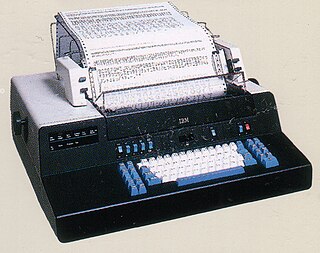Related Research Articles

The IBM 3270 is a family of block oriented display and printer computer terminals introduced by IBM in 1971 and normally used to communicate with IBM mainframes. The 3270 was the successor to the IBM 2260 display terminal. Due to the text color on the original models, these terminals are informally known as green screen terminals. Unlike a character-oriented terminal, the 3270 minimizes the number of I/O interrupts required by transferring large blocks of data known as data streams, and uses a high speed proprietary communications interface, using coaxial cable.

Multiple Virtual Storage, more commonly called MVS, is the most commonly used operating system on the System/370, System/390 and IBM Z IBM mainframe computers. IBM developed MVS, along with OS/VS1 and SVS, as a successor to OS/360. It is unrelated to IBM's other mainframe operating system lines, e.g., VSE, VM, TPF.

VSEn is an operating system for IBM mainframe computers, the latest one in the DOS/360 lineage, which originated in 1965. It is less common than z/OS and is mostly used on smaller machines.

OS/390 is an IBM operating system for the System/390 IBM mainframe computers.
Systems Network Architecture (SNA) is IBM's proprietary networking architecture, created in 1974. It is a complete protocol stack for interconnecting computers and their resources. SNA describes formats and protocols but, in itself, is not a piece of software. The implementation of SNA takes the form of various communications packages, most notably Virtual Telecommunications Access Method (VTAM), the mainframe software package for SNA communications.

VM is a family of IBM virtual machine operating systems used on IBM mainframes System/370, System/390, zSeries, System z and compatible systems, including the Hercules emulator for personal computers.
Interlink Computer Sciences, Inc., of Fremont, California, was a developer of hardware and software that allowed IBM mainframe computers running the MVS operating system to be connected to non-IBM networks.
Remote job entry, or Remote Batch, is the procedure for sending requests for non-interactive data processing tasks (jobs) to mainframe computers from remote workstations, and by extension the process of receiving the output from such jobs at a remote workstation.

A 3270 Emulator is a terminal emulator that duplicates the functions of an IBM 3270 mainframe computer terminal on a computer, usually a PC or similar microcomputer.
In computing, Advanced Program to Program Communication or APPC is a protocol which computer programs can use to communicate over a network. APPC is at the application layer in the OSI model, it enables communications between programs on different computers, from portables and workstations to midrange and host computers. APPC is defined as VTAM LU 6.2

The IBM 3705 Communications Controller is a simple computer which attaches to an IBM System/360 or System/370. Its purpose is to connect communication lines to the mainframe channel. It was a first communications controller of the popular IBM 37xx series. It was announced in March 1972. Designed for semiconductor memory which was not ready at the time of announcement, the 3705-I had to use 1.2 microsecond core storage; the later 3705-II uses 1.0 microsecond SRAM. Solid Logic Technology components, similar to those in S/370, were used.
Binary Synchronous Communication is an IBM character-oriented, half-duplex link protocol, announced in 1967 after the introduction of System/360. It replaced the synchronous transmit-receive (STR) protocol used with second generation computers. The intent was that common link management rules could be used with three different character encodings for messages.
IBM Advanced Peer-to-Peer Networking (APPN) is an extension to the Systems Network Architecture (SNA) "that allows large and small computers to communicate as peers across local and wide-area networks."

Teleprocessing Network Simulator (TPNS) is an IBM licensed program, first released in 1976 as a test automation tool to simulate the end-user activity of network terminal(s) to a mainframe computer system, for functional testing, regression testing, system testing, capacity management, benchmarking and stress testing.

IBM 37xx is a family of IBM Systems Network Architecture (SNA) programmable communications controllers used mainly in mainframe environments.
The IBM Network Control Program, or NCP, was software that ran on a 37xx communications controller and managed communication with remote devices. NCP provided services comparable to the data link layer and Network Layer functions in the OSI model of a Wide area network.
The IBM 2780 and the IBM 3780 are devices developed by IBM for performing remote job entry (RJE) and other batch functions over telephone lines; they communicate with the mainframe via Binary Synchronous Communications and replaced older terminals using synchronous transmit-receive (STR). In addition, IBM has developed workstation programs for the 1130, 360/20, 2922, System/360 other than 360/20, System/370 and System/3.

The IBM 3745 is the latest and last of a 37xx family of communications controllers for the IBM mainframe environment. As of mid-2009 there were an estimated 7,000+ of the larger 3745 models still in active production status, down from 20,000 or more in 2007. The 3745 and associated 3746 models were once heavily used within financial, insurance and retail industries as well as within government agencies globally. However, today most organizations have migrated away from the use of 3745s. IBM's Enterprise Extender and the Communication Controller for Linux on System z (CCL) have largely displaced the older 3745s. IBM announced in September 2002 that it would no longer manufacture new 3745s, but IBM continues to support the hardware by providing worldwide maintenance service, by providing microcode releases and by supporting the associated software including NCP and the virtual telecommunications access method (VTAM). IBM has announced end-of-service dates for Japan, Europe and the Middle East, but has not yet announced end-of-service for the Americas and parts of Asia.
An access method is a function of a mainframe operating system that enables access to data on disk, tape or other external devices. Access methods were present in several mainframe operating systems since the late 1950s, under a variety of names; the name access method was introduced in 1963 in the IBM OS/360 operating system. Access methods provide an application programming interface (API) for programmers to transfer data to or from device, and could be compared to device drivers in non-mainframe operating systems, but typically provide a greater level of functionality.

IBM 3767 Communication Terminal is a serial printer terminal that employed dot matrix print-head technology and, for the first time, the Synchronous Data Link Control (SDLC) communications protocol set under IBM's Systems Network Architecture (SNA). It was introduced in 1974 and was used widely during the late 1970s to 1990s, for attachment to IBM System/360 and System/370 mainframe computers and IBM System/7 as an alternative to a 2741 typewriter terminal.
References
- ↑ IBM Corporation (2011). ABCs of z/OS System Programming Volume 4 (PDF).
- ↑ Frank, Ronald A (October 17, 1973). "IBM Delays Second Virtual TP Release; SD:C Impact Expected". Computerworld. Retrieved June 30, 2020.
- ↑ IBM Corporation (8 August 2001). "5735-RC2 IBM Advanced Communication Function for VTAM (ACF/VTAM) V1 R1 for OS/VS". Archived from the original on 2016-03-04. Retrieved June 30, 2020.
- ↑ Introduction to Advanced Communications Function (PDF). IBM. May 1979. GC30-3033-1. Archived from the original (PDF) on 2017-11-26.
- ↑ Network Program Products: General Information (PDF). IBM. September 1985. GC27-0657-2.
- ↑ Introduction to VTAM (PDF). IBM. April 1976. GC27-6987-5.
- ↑ "z/OS Communication Server: SNA Network Implementation Guide - Static definition of cross-domain resources". IBM.
- ↑ "z/OS Communication Server: SNA Resource Definition Samples - Connecting multiple networks using SNA network interconnection". IBM.
- ↑ "Networking on z/OS - Introduction to APPN". IBM.